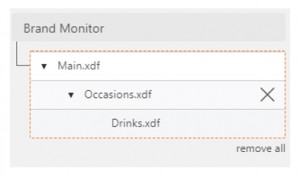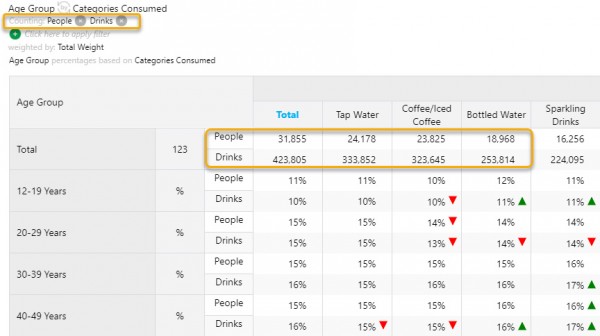Share this
Leverage the power of multi-level survey analysis in Harmoni
by Infotools on 03 Dec 2020
New functionality added to Harmoni allows users to automatically cross-reference layers of survey data, streamlining the analysis and visualization of multi-level (hierarchical) survey data.
The complexity surrounding consumer behavior seems to be increasing on a daily basis. Decision-making processes are not linear, and people experience multiple touchpoints with products, services and brands. As marketers and market researchers, we must examine the context that is driving people’s choices and behaviors. Keeping up is harder than ever, with data coming from all directions. How does it all fit together?
To better understand their audience behaviors, motivations, and why they do what they do, many brands present survey questionnaires that are somewhat complex. For example, let’s consider a survey that includes questions about people’s feelings, as well as questions about events in which those people have been involved. The data from that survey can be presented in two or more levels. One level represents the sentiment and other characteristics of the respondents (people), and the other level represents the events (such as consumption occasions).

When data is collected in this way, it is possible to look at all the relationships between the characteristics of the people (such as age, occupation, gender, and other demographics) and the characteristics of their “events” (such as when and where they consumed a drink, what brand it was, etc). Being able to layer information and compare relationships between layers of data is essential when seeking a deeper understanding of consumer motivations.

There are several solutions that can bring various sources of data together for analysis, such as “stacked” databases. But, really understanding and cross-referencing the data has traditionally required a lot of manual data preparation. A few of the pitfalls traditionally encountered in this type of analysis include:
- Manual manipulation of the datafiles, leaving the data open to human error
- Inaccessibility of the data by general research teams, requiring the intervention of the advanced research team or vendor
- Difficulty in interpreting data and calculating percentages
- Manual replication of data across the levels, risking another layer of possible human error and potential for misinterpretation
- Lack of flexibility in meeting stakeholder needs, when the information needed was not already stacked and processed
The bottom line is that we just simply don’t have time (and can’t afford the possibility of errors) to analyze multi-level data using traditional, manual-heavy methods. Many technology-driven solutions that solve a handful of these inefficiencies still don’t intrinsically work with a market researcher’s unique needs in mind, and analysis can still prove cumbersome.
Harmoni was built by market researchers who know just how important this kind of analysis is to understand an audience and their behaviors. With it, you have an elegant and streamlined solution for important multi-level survey analysis, which improves your workflow in several key ways:
- Immediately connect and cross the levels (such as stacked and unstacked data)
- No need to manually replicate the data within the levels
- Easy to switch between levels, cross-reference them against one another and automatically get the most relevant results (such as average number of occasions per respondent or number of drinks per occasion)
- No latency, no database downloads to remember, and no need for tracking versions
- Leverage the data easily without the need for scripting
- As new data arrives, see the impact of the new wave immediately in the multi-level analysis and reports.
When analyzing multi-level data, the difference between various views can sometimes be overwhelming and challenging because it is so complex. To add to the fun, you must also ensure that the insights you are uncovering will correctly and thoroughly answer the business questions at hand. Harmoni’s user-friendly approach makes these kinds of analyses intuitive.
Harmoni offers the perfect solution for undertaking multi-level survey data analysis. It is ideal for researchers who are:
- Collecting consumer diary data and survey questionnaire data for CPG or FMPG brands
- Seeking to understand occasion-driven behavior using multi-occasion behavioral and segmentation data
- Looking to drive business decisions with the five Ws (and H) marketing method - everything from what consumers are doing to why and how they are doing them
- Dealing with brand or product profiling studies or normed databases
Gaining a deeper understanding of your customer just got easier!
Share this
- March 2025 (6)
- February 2025 (3)
- January 2025 (4)
- December 2024 (5)
- November 2024 (6)
- October 2024 (4)
- September 2024 (4)
- August 2024 (6)
- July 2024 (7)
- June 2024 (4)
- May 2024 (7)
- April 2024 (6)
- March 2024 (3)
- February 2024 (8)
- January 2024 (3)
- December 2023 (6)
- November 2023 (5)
- October 2023 (3)
- September 2023 (8)
- August 2023 (4)
- July 2023 (6)
- June 2023 (6)
- May 2023 (3)
- April 2023 (6)
- March 2023 (6)
- February 2023 (4)
- January 2023 (2)
- December 2022 (2)
- November 2022 (8)
- October 2022 (6)
- September 2022 (6)
- August 2022 (7)
- July 2022 (5)
- June 2022 (6)
- May 2022 (5)
- April 2022 (4)
- March 2022 (8)
- February 2022 (7)
- January 2022 (1)
- December 2021 (2)
- November 2021 (2)
- July 2021 (4)
- June 2021 (2)
- May 2021 (4)
- April 2021 (2)
- March 2021 (5)
- February 2021 (3)
- January 2021 (3)
- December 2020 (1)
- November 2020 (5)
- October 2020 (2)
- September 2020 (5)
- August 2020 (4)
- July 2020 (4)
- June 2020 (1)
- May 2020 (3)
- April 2020 (6)
- March 2020 (3)
- February 2020 (4)
- January 2020 (2)
- December 2019 (4)
- November 2019 (4)
- October 2019 (3)
- September 2019 (2)
- August 2019 (4)
- July 2019 (5)
- June 2019 (2)
- May 2019 (4)
- April 2019 (4)
- March 2019 (2)
- February 2019 (4)
- January 2019 (3)
- December 2018 (5)
- November 2018 (2)
- October 2018 (1)
- September 2018 (3)
- August 2018 (5)
- June 2018 (4)
- May 2018 (4)
- April 2018 (3)
- December 2017 (1)
- November 2017 (2)
- October 2017 (1)
- September 2017 (3)
- August 2017 (2)
- June 2017 (2)
- February 2017 (2)
- January 2017 (2)
- December 2016 (2)
- September 2016 (1)

No Comments Yet
Let us know what you think